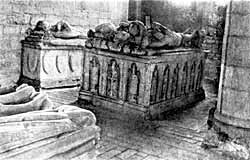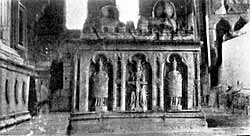 St Mary's church, Willoughby-on-the-Wolds. Interior
of St. Nicholas Chapel.
St Mary's church, Willoughby-on-the-Wolds. Interior
of St. Nicholas Chapel.During the first quarter of the 14th century, alabaster was introduced for funerary effigies. This beautiful material can be delicately carved, and its use enabled tomb-makers to dispense with the use of gesso. The delicacy of carving in alabaster attracted artists to the trade, and the beautiful art of alabaster carving reached its zenith in the early 15th century, Nottingham being one of the chief centres of the industry.
There are eight figures in the chapel at Willoughby, and of these the four lying at the west end are the oldest. They are not in their original positions and they are older than the chapel. Of the two ladies lying side by side to the north, nothing is known. They are in an attitude of devotion, and as they wear wimples they are possibly widows vowed not to marry again. The knight, whose figure is a core from which the gesso has disappeared, is identified as Sir Richard Willoughby. He was son to Richard Bugge, younger brother of Ralph Bugge and, therefore, nephew to the founder of the Willoughby family. He was commissioner of Oyer and Terminer in 1311 and 1314, and was placed on the commission of peace for the counties of Nottingham and Derby. He died in 1325.
By the north wall lies an effigy of another Sir Richard Willoughby, son to the last-named Sir Richard. He was a Justice of Common Pleas for twenty-eight years in the reign of Edward III, and acted as Chief Justice during the absence abroad of Chief Justice Scroop. He married, as his first wife, Isabella de Mortein, who brought as part of her dowry the Wollaton estates and so commenced the long connexion of the Willoughby family with Wollaton. A curious story is told of him. In 1331 a band of outlaws who called themselves “Gents Savages” infested and terrorised the country from Grantham to Buxton. Amongst other crimes they kidnapped Sir Richard, and carrying him into a wood they kept him prisoner until a ransom of ninety marks (about £60) was forthcoming. This so incensed the judge that he took strong measures to clear the countryside of miscreants. His figure is beautifully carved, and it will be noticed that he wears his anlace or dagger on his right side where it would be of little use. It is, indeed, little more than a badge of office.
 St Mary's church, Willoughby-on-the-Wolds. Detail
of Trinity on Sir Hugh Willoughby's Tomb.
St Mary's church, Willoughby-on-the-Wolds. Detail
of Trinity on Sir Hugh Willoughby's Tomb.Under the eastern arch leading into the church lies Sir Richard Willoughby, son of the judge. He married a sister of Lord Grey. No effigy of her remains, but her arms—Barry of six, gold and blue—are displayed on the tomb, which confirms the identification. The knight wears the camail, and on his jupon may be seen the Willoughby arms. The three water-bougets, or skins suitable for carrying water, hanging from each side of a yoke, which are so prominent in the Willoughby arms, are evidently a pun on the family name of Bugge, which was probably pronounced “Booge.”
The armour shown on this figure is of great use in identification, for there was as definite a fashion in armour as in dress or in architecture.
Norman armour consisted of a series of rings, independent of each other, sewn on to a leather jacket, and was worn during the reigns of William I, William II, Henry I, Stephen and Henry II—roughly from 1066 to 1190. It was followed by chain mail, made up of interlocked iron rings, and this form was in use during the time of Richard I, John, Henry III and Edward I—i.e. from c.1190 to 1290. Edwardian armour, from c.1290 to 1370, consisted of chain mail reinforced by plates at danger points such as the shoulders, elbows and knees. The jupon or padded cloak worn over the armour and blazoned with the arms of the wearer, came into use about the time of Edward III and remained fashionable during the times of Richard II and Henry IV: 1330-1400. Then followed plate armour, romantic and beautiful, but exceedingly difficult to keep clean, which lasted until armour was abandoned. Towards the end of the Wars of the Roses the jupon gave place to the shorter tabard—like those worn by heralds nowadays as an overgarment—and the final phase was reached during the reign of Henry VIII when gunpowder had rendered armour nearly useless, and elaborate tilting armour with wonderful ornamentation—known as Maximilian armour—was used for tournaments and display purposes. Breastpieces and so on lingered on during the 17th century, but by the 18th century armour was found to be almost useless.
The great double tomb represents Sir Hugh Willoughby who died in 1445. His first wife was Isabella Foljambe who died in 1417 and who lies under a floor-slab to the south of her husband. His second wife, who rests by his side, was Margaret Freville. She brought the Middleton estates into the family, and when the Willoughbys were ennobled by Queen Anne in 1711, they took the title of Middleton, from the estates brought by this lady. These are the last Willoughbys to be buried at Willoughby. Thereafter, Wollaton was used as their dormitory.
The figures on the tomb wear costumes characteristic of the period, and angels, holding shields, occupy sixteen panels round the tomb. At the west end of the tomb is a Trinity of the normal medieval type, and at the east end is an unusual Madonna holding the Infant in her left arm and a posy in her right hand.
Bibliography
Church and Monuments, Thoroton Transactions, 1902, p. 45, etc.; and Thoroton Transactions, 1924, p. 128, etc.
Arms, Armour and Alabaster, p. 29.
“Willoughby Family,” Thoroton Transactions, 1902, p. 43.
